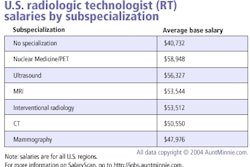BOSTON - Compliance programs with government regulations are generally thought to be part of the administrative cost of doing business: an overhead item that is required, which adds nothing but more paperwork to an imaging center practice. Crafted properly, however, a compliance program can reduce both regulatory and fiscal liabilities, according to a presentation at the American Healthcare Radiology Administrators annual conference on Sunday.
"Before beginning an imaging center compliance program, you need to decide what type of practice you're going to operate -- an imaging center or an independent diagnostic testing facility," said Maureen Brooks, corporate compliance officer for Radiology Practice Management in Long Beach, CA.
A designation as an imaging center allows a practice to provide therapeutic care as well as diagnostic imaging services. An independent diagnostic testing facility is a more restrictive designation with more rules and guidelines attached, Brooks said.
Policies and procedures
Regardless of the imaging business model selected by a practice, it will need its own compliance program, which consists of several elements. The first of these are the development of written standards of conduct, policies, and procedures, she said.
"This section is to establish and promote an organization's commitment to compliance, as well as to allow specific areas of potential fraud to be addressed," Brooks said.
The risk areas of potential fraud and abuse for an imaging center practice are:
- Billing for items not rendered.
- Providing medically unnecessary services.
- Duplicate billing.
- Unbundling.
- Credit balances.
These risk areas can be particularly troublesome if an imaging center is a joint venture between a hospital and a physician practice with some billing elements handled by the hospital and some handled by the practice. Brooks emphasized that these risk areas are probably the most important and significant elements that need to be addressed in a compliance program.
Officer, education, and training
A compliance program must have a designated compliance officer and a compliance committee. The compliance officer, normally a person who has other duties in the practice, is responsible for the operation and maintenance of the program. This individual reports to the chief executive officer and governing body, must be knowledgeable about the practice, and should have a high level of responsibility according to Brooks.
A compliance education and training program needs to be created for all employees touched with a regulatory responsibility, such as HIPAA. In addition, the governing board and management, as well as vendors who are frequently in the facility, will need to be part of this education and training program. The education and training must be tailored to the needs of each group, Brooks said.
Non-compliance, enforcement, and discipline
A process must be created to report non-compliance in the imaging center practice. There needs to be a written policy of how complaints will be received and includes provisions to protect the anonymity of complainants and shield them from retaliation, she said.
A practice will also need to create a system to respond to allegations of improper activities. This should have specific steps that will be taken to promote proper conduct, as well as outline the enforcement of actions that can be taken against employees who have violated policies.
Auditing and monitoring
Auditing and monitoring compliance programs are the best way of evaluating the effectiveness of the programs, Brooks said. In addition to identifying problem areas for correction in a practice, internal auditing and monitoring provides a mechanism for employees to seek compliance guidance.
"I recommend that compliance audits be done on a monthly basis in the first year of an imaging center's operation," Brooks said.
One of the most useful audits a new or existing practice can implement is denial management. This involves tracking denials based on type:
- Not medically necessary.
- Frequency of service.
- No authorizations.
"Managed-care payors, for whatever reason, tend to be a little slower in reimbursing outpatient imaging centers, so denial management is a very important part of your business," she said.
In Brooks' practice, she tracks denials against each procedure and related CPT code that the group performs. This is further broken down by the type of denial issued so that the practice can take remedial action. This could be an administrative action, such as obtaining more complete patient histories for the frequency of service denials, or it could be an education action, such as informing referring physicians about guidelines covering procedures judged to have been not medically necessary.
Denial management also lets a practice know its percentage of denials against the total number of clinical procedures, Brooks said. This information allows an imaging center to focus its energies on bringing problematic procedures into compliance, as well as to correct and resubmit denied claims for reimbursement.
Corrective action
The final element in an imaging center compliance program is to develop a mechanism for corrective action. This needs to encompass methodology for the investigation and remediation of identified systemic problems, Brooks said. Policies must be developed that prohibit the employment of sanctioned individuals, and that outline reasonable steps to respond to and prevent further criminal conduct, she said.
"Any policy that you implement has to be testable," she said. "If you can't test it, how are you going to determine whether or not it's working?"
By Jonathan S. Batchelor
AuntMinnie.com staff writer
August 2, 2004
Related Reading
Radiology group pays $2.5 million to settle alleged Medicare fraud, June 29, 2004
Automated claim coding pays off in time and money, May 11, 2004
Diligent coding means money in the bank for breast imaging, May 21, 2004
Billing mistakes cost Medicare $11.6 billion, U.S. says, November 17, 2003
Demystifying the internal auditing program, October 16, 2002
Copyright © 2004 AuntMinnie.com



















